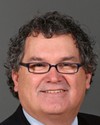Thank you, Mr. Chair.
I appreciate the testimony from our witnesses. I'm going to first of all start by saying how pleased I am to see, Eric, that you are using your own wherewithal and your own means to do this. I think it's commendable. As an Albertan, I do believe that good things always come out of Alberta. Good ideas come out of Alberta. It's nice to see you.
I have a similar situation to you. I'm a sport fisherman; I love sport fishing. My interest in being on this committee is primarily from that perspective, but my background as well.... So I wanted to say thank you for the work that you're doing and for the seemingly middle-of-the-road approach where you're actually trying to find a solution where we have what appears to me, and before this committee, very divided parties coming together. It makes it easier for policy analysts and policy setters like us to hear from all those sides. It's nice to hear it from somebody who comes from a more tactful approach in trying to find a legitimate solution to the issue.
I do have some questions for you. On the closed containment issue, I believe there are some significant barriers in the knowledge there. Andrew, I know that you're working hard on this. Perhaps you could elaborate on some of this for me. My understanding is that the business model includes, obviously, using the waste product for lettuce. I'm not sure that there's a gap in the marketplace for lettuce. I think flooding the marketplace with lettuce would probably drive the price down, which might affect your model.
I also think that your proposal suggests that there are various different stages of cohorts involved in the same pens, at the same time, in the same tanks. Salmonids are piscivorous, which means they eat each other. Also, I'm a farm boy from Alberta and I know from intensive livestock operations that you don't grow different sizes of animals in the same pen at the same time. That kind of thinking doesn't work. So if that's the case in your model, could you elaborate on that?
I'd be very curious to find out how Overwaitea has dealt with this. Obviously they're finding a market for this; they're selling this fish. From my experience with fish farming, if you take a freshwater-raised salmonid and compare that to a farm-raised saltwater salmonid, and you compare that to a wild saltwater salmonid, the taste and palatability of those fish across that spectrum varies significantly due to the various issues pertaining to their growth. I'm hoping that you can address some of those.
This is something that's never been brought up in any of these discussions--and I think Ron MacDonald was highlighting that. His fear, as part of the sablefish organization, was that farmed sablefish will be called the same thing as wild sablefish. We haven't had a discussion. At any rate, farmed salmon are called Atlantic salmon. If you read the literature out there, when you take a look at what happened to the Patagonian toothfish, it was sold as Chilean sea bass to distort feelings in the marketplace or to confuse the consumer. So we haven't had very much discussion about whether we're accurately labelling what consumers are buying.
I would appreciate anybody's input on that.
Also, Dr. Orr, I would like to know this. Pharmaceutical companies, from my understanding, are often looking for new ways to access the marketplace. Is there anything that you know of or that you could enlighten this committee with? I would imagine if a problem is presenting itself through sea lice resistance, a pharmaceutical company would be looking to fill that gap. Could you let us know if there's anything new that's being tested or that's being proposed in a push towards the market to head off what everybody seems to see as an inevitable situation?
Thank you.




